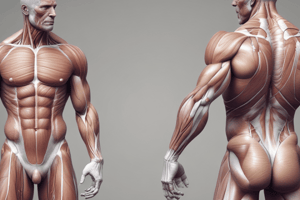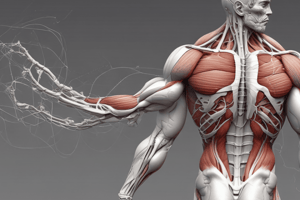Podcast
Questions and Answers
Type I muscle fibers are specialized for high-force generation.
Type I muscle fibers are specialized for high-force generation.
False (B)
The A-band of a sarcomere is composed of thin filaments.
The A-band of a sarcomere is composed of thin filaments.
False (B)
Muscle spindles are responsible for regulating muscle tone and posture.
Muscle spindles are responsible for regulating muscle tone and posture.
True (A)
A motor unit consists of multiple motor neurons innervating a single muscle fiber.
A motor unit consists of multiple motor neurons innervating a single muscle fiber.
Type IIb muscle fibers have high myoglobin content and many mitochondria.
Type IIb muscle fibers have high myoglobin content and many mitochondria.
Pennation refers to the direction of muscle fibers within a muscle.
Pennation refers to the direction of muscle fibers within a muscle.
The M-line is a region of thin filaments with actin heads.
The M-line is a region of thin filaments with actin heads.
Muscle contraction occurs through the binding of actin and myosin filaments.
Muscle contraction occurs through the binding of actin and myosin filaments.
Muscle architecture refers to the organization of motor neurons and muscle fibers.
Muscle architecture refers to the organization of motor neurons and muscle fibers.
Intrafusal fibers are found within muscle spindles and are responsible for contraction.
Intrafusal fibers are found within muscle spindles and are responsible for contraction.
Flashcards are hidden until you start studying
Study Notes
Muscle Fiber Types
- There are three main types of muscle fibers:
- Type I (Slow-Twitch) Fibers:
- High endurance, low force generation
- Rich in myoglobin, many mitochondria
- Used for low-intensity, long-duration activities
- Type IIa (Fast-Twitch Oxidative) Fibers:
- High force generation, moderate endurance
- High myoglobin content, many mitochondria
- Used for high-intensity, short-duration activities
- Type IIb (Fast-Twitch Glycolytic) Fibers:
- High force generation, low endurance
- Low myoglobin content, few mitochondria
- Used for high-intensity, short-duration activities
- Type I (Slow-Twitch) Fibers:
Sarcomere Structure
- A sarcomere is the functional unit of muscle contraction:
- Consists of:
- A-band: thick filaments (myosin)
- I-band: thin filaments (actin)
- H-zone: region of thick filaments without thin filaments
- M-line: region of thick filaments with myosin heads
- Z-line: region of thin filaments anchored to sarcolemma
- Consists of:
- Muscle contraction occurs through the sliding filament theory:
- Actin and myosin filaments slide past each other, increasing muscle length
Muscle Spindle Function
- Muscle spindles are sensory organs within muscles:
- Consist of:
- Intrafusal fibers: specialized muscle fibers
- Sensory endings: detect changes in muscle length
- Consist of:
- Function:
- Monitor muscle length and velocity
- Provide feedback to the nervous system for motor control
- Help regulate muscle tone and posture
Motor Unit Organization
- A motor unit is a group of muscle fibers innervated by a single motor neuron:
- Consists of:
- Motor neuron: transmits signals to muscle fibers
- Muscle fibers: contract in response to motor neuron signals
- Consists of:
- Motor units are the functional units of muscle contraction:
- Recruitment of motor units determines muscle force generation
Muscles Characteristics
- Muscles have several characteristic features:
- ** pennation**: angle at which muscle fibers attach to tendons
- ** fiber orientation**: direction of muscle fibers within a muscle
- ** muscle architecture**: organization of muscle fibers and connective tissue
- These characteristics influence muscle function and movement patterns
Muscle Fiber Types
- There are three main types of muscle fibers, each with distinct characteristics and functions.
- Type I (Slow-Twitch) Fibers: high endurance, low force generation, rich in myoglobin, and many mitochondria, used for low-intensity, long-duration activities.
- Type IIa (Fast-Twitch Oxidative) Fibers: high force generation, moderate endurance, high myoglobin content, and many mitochondria, used for high-intensity, short-duration activities.
- Type IIb (Fast-Twitch Glycolytic) Fibers: high force generation, low endurance, low myoglobin content, and few mitochondria, used for high-intensity, short-duration activities.
Sarcomere Structure
- A sarcomere is the functional unit of muscle contraction, consisting of:
- A-band: thick filaments (myosin).
- I-band: thin filaments (actin).
- H-zone: region of thick filaments without thin filaments.
- M-line: region of thick filaments with myosin heads.
- Z-line: region of thin filaments anchored to sarcolemma.
- Muscle contraction occurs through the sliding filament theory, where actin and myosin filaments slide past each other, increasing muscle length.
Muscle Spindle Function
- Muscle spindles are sensory organs within muscles, consisting of:
- Intrafusal fibers: specialized muscle fibers.
- Sensory endings: detect changes in muscle length.
- Muscle spindles function to:
- Monitor muscle length and velocity.
- Provide feedback to the nervous system for motor control.
- Help regulate muscle tone and posture.
Motor Unit Organization
- A motor unit is a group of muscle fibers innervated by a single motor neuron, consisting of:
- Motor neuron: transmits signals to muscle fibers.
- Muscle fibers: contract in response to motor neuron signals.
- Motor units are the functional units of muscle contraction, and recruitment of motor units determines muscle force generation.
Muscles Characteristics
- Muscles have several characteristic features that influence muscle function and movement patterns, including:
- Pennation: angle at which muscle fibers attach to tendons.
- Fiber orientation: direction of muscle fibers within a muscle.
- Muscle architecture: organization of muscle fibers and connective tissue.
Studying That Suits You
Use AI to generate personalized quizzes and flashcards to suit your learning preferences.




